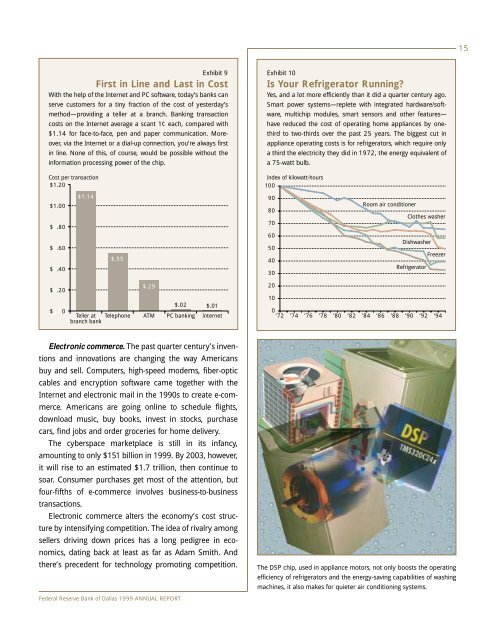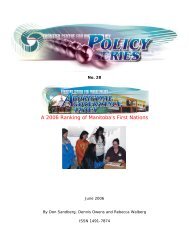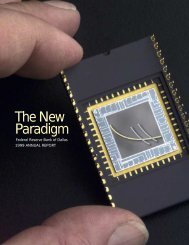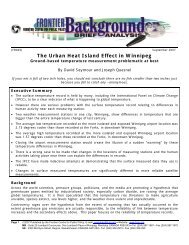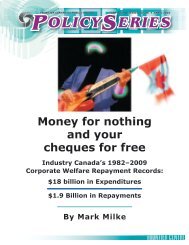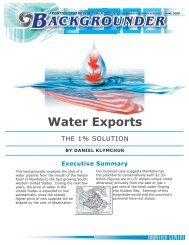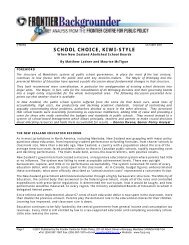The New Paradigm - Federal Reserve Bank of Dallas
Create successful ePaper yourself
Turn your PDF publications into a flip-book with our unique Google optimized e-Paper software.
15<br />
Exhibit 9<br />
First in Line and Last in Cost<br />
With the help <strong>of</strong> the Internet and PC s<strong>of</strong>tware, today’s banks can<br />
serve customers for a tiny fraction <strong>of</strong> the cost <strong>of</strong> yesterday’s<br />
method—providing a teller at a branch. <strong>Bank</strong>ing transaction<br />
costs on the Internet average a scant 1¢ each, compared with<br />
$1.14 for face-to-face, pen and paper communication. Moreover,<br />
via the Internet or a dial-up connection, you’re always first<br />
in line. None <strong>of</strong> this, <strong>of</strong> course, would be possible without the<br />
information processing power <strong>of</strong> the chip.<br />
Exhibit 10<br />
Is Your Refrigerator Running?<br />
Yes, and a lot more efficiently than it did a quarter century ago.<br />
Smart power systems—replete with integrated hardware/s<strong>of</strong>tware,<br />
multichip modules, smart sensors and other features—<br />
have reduced the cost <strong>of</strong> operating home appliances by onethird<br />
to two-thirds over the past 25 years. <strong>The</strong> biggest cut in<br />
appliance operating costs is for refrigerators, which require only<br />
a third the electricity they did in 1972, the energy equivalent <strong>of</strong><br />
a 75-watt bulb.<br />
Cost per transaction<br />
$1.20<br />
Index <strong>of</strong> kilowatt-hours<br />
100<br />
$1.00<br />
$0.80<br />
$0.60<br />
$0.40<br />
$1.14<br />
$.55<br />
90<br />
80<br />
70<br />
60<br />
50<br />
40<br />
30<br />
Room air conditioner<br />
Clothes washer<br />
Dishwasher<br />
Freezer<br />
Refrigerator<br />
$0.20<br />
$0.00<br />
Teller at<br />
branch bank<br />
Telephone<br />
$.29<br />
ATM<br />
$.02<br />
PC banking<br />
$.01<br />
Internet<br />
20<br />
10<br />
0<br />
’72<br />
’74<br />
’76<br />
’78<br />
’80<br />
’82<br />
’84<br />
’86<br />
’88<br />
’90<br />
’92<br />
’94<br />
Electronic commerce. <strong>The</strong> past quarter century’s inventions<br />
and innovations are changing the way Americans<br />
buy and sell. Computers, high-speed modems, fiber-optic<br />
cables and encryption s<strong>of</strong>tware came together with the<br />
Internet and electronic mail in the 1990s to create e-commerce.<br />
Americans are going online to schedule flights,<br />
download music, buy books, invest in stocks, purchase<br />
cars, find jobs and order groceries for home delivery.<br />
<strong>The</strong> cyberspace marketplace is still in its infancy,<br />
amounting to only $151 billion in 1999. By 2003, however,<br />
it will rise to an estimated $1.7 trillion, then continue to<br />
soar. Consumer purchases get most <strong>of</strong> the attention, but<br />
four-fifths <strong>of</strong> e-commerce involves business-to-business<br />
transactions.<br />
Electronic commerce alters the economy’s cost structure<br />
by intensifying competition. <strong>The</strong> idea <strong>of</strong> rivalry among<br />
sellers driving down prices has a long pedigree in economics,<br />
dating back at least as far as Adam Smith. And<br />
there’s precedent for technology promoting competition.<br />
<strong>Federal</strong> <strong>Reserve</strong> <strong>Bank</strong> <strong>of</strong> <strong>Dallas</strong> 1999 ANNUAL REPORT<br />
<strong>The</strong> DSP chip, used in appliance motors, not only boosts the operating<br />
efficiency <strong>of</strong> refrigerators and the energy-saving capabilities <strong>of</strong> washing<br />
machines, it also makes for quieter air conditioning systems.


